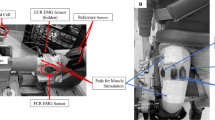Summary
Muscles from cats, rats, guinea pigs and mice have been investigated as preparations for visualizing mammalian neuromuscular junctions with the aid of Nomarski interference optics. The M. omohyoideus of the mouse was found to be most convenient. Electrophysiological investigations showed that an endplate is normally surrounded by a population of perijunctional receptors. For junctional receptors in the endplate, a Hill coefficient ofn H=2.6 for acetylcholine was determined at 38°C, decreasing to a value of 2.3 at room temperature. For both perijunctional and extrajunctional receptors (the latter occurring after denervation), the coefficientn H was 1.9. Noise analysis revealed a channel conductance γ which changed abruptly from 22.4±1.0 pS (10–23°C) to 45.6±0.9 pS (34–39°C) in a very small temperature range around 25.5°C. The mean channel lifetime τ was 0.3 ms at 39°C and 1.0 ms at 23°C.
Similar content being viewed by others
References
Anderson C. R., Stevens, C. F.: Voltage clamp analysis of acetylcholine produced end-plate current fluctuations at frog neuromuscular junction. J. Physiol. (Lond.)235, 655–691 (1973)
Ben-Haim, D., Dreyer, F., Peper, K.: Acetylcholine receptor: modification of synaptic gating mechanism after treatment with a disulfide bond reducing agent. Pflügers Arch.355, 19–26 (1975)
Colquhoun, D.: Analysis of end-plate current fluctuations produced by acetylcholine and acetylmonoethylcholine in rat muscle. Brit. J. Pharmacol (in press, 1976)
Dreyer, F., Peper, K.: A monolayer preparation of innervated skeletal muscle fibres of the M. cutaneus pectoris of the frog. Pflügers Arch.348, 257–262 (1974a)
Dreyer, F., Peper, K.: Iontophoretic application of acetylcholine: advantages of high resistance micropipettes in connection with an electronic current pump. Pflügers Arch.348, 263–272 (1974b)
Dreyer, F., Peper, K.: The acetylcholine sensitivity in the vicinity of the neuromuscular junction of the frog. Pflügers Arch.348, 273–286 (1974c)
Dreyer, F., Peper, K.: The spread of acetylcholine sensitivity after denervation of frog skeletal muscle fibres. Pflügers Arch.348, 287–292 (1974d)
Dreyer, F., Müller, K.-D., Peper, K., Sterz, R.: Temperature dependence of ionic channel properties of ACh-receptors at frog and mouse neuromuscular junctions. Pflügers Arch.365, R36 (1976)
Dreyer, F., Walther, Chr., Peper, K.: Junctional and extrajunctional acetylcholine receptors in normal and denervated frog muscle fibres: noise analysis experiments with different agonists. Pflügers Arch.366, 1–9 (1976)
Hartzell, H. C., Kuffler, S. W., Yoshikami, D.: Post-synaptic potentiation: interaction between quanta of acetylcholine at the skeletal neuromuscular synapse. J. Physiol. (Lond.)251, 427–463 (1975)
Helenius, A., Simons, K.: Solubilization of membranes by detergents. Biochim. biophys. Acta (Amst.)415, 29–79 (1975)
Karnovsky, M. J.: The localization of cholinesterase activity in rat cardiac muscle by electron microscopy. J. Cell Biol.23, 217–232 (1964)
Katz, B., Miledi, R.: The statistical nature of the acetylcholine potential and its molecular components. J. Physiol. (Lond.)224, 665–699 (1972)
Kölliker, A.: Untersuchungen über die letzten Endigungen der Nerven. Mit 4 Kupfertafeln. Leipzig: W. Engelmann 1862
Krause, W.: Über die Endigung der Muskelnerven. Z. rat. Med.18, 136–160 (1863)
Kühne, W.: Über die peripherischen Endorgane der motorischen Nerven. Mit 5 Tafeln. Leipzig: W. Engelmann 1862
Kühne, W.: Über die Endigung der Nerven in den Muskeln. Virchow Arch.27, 508–533 (1863)
Miledi, R.: Junctional and extra-junctional acetylcholine receptors in skeletal muscle fibres. J. Physiol. (Lond.)151, 24–30 (1960)
Miledi, R.: Induction of receptors. In: Ciba Found. Symp. Enzymes and Drug Action, pp. 220–235 (1962)
Müller, K.-D., Dreyer, F., Peper, K.: Convenient mammalian skeletal muscle preparations for experiments at single endplates under visual control. Pflügers Arch.362, R30 (1976)
Peper, K., Dreyer, F., Müller, K.-D.: Analysis of cooperativity of drug-receptor interaction by quantitative iontophoresis at frog motor end-plates. In: The synapses. Cold Spr. Harb. Symp. quant. Biol.XL, 187–192 (1975)
Peper, K., McMahan, U. J.: Distribution of acetylcholine receptors in the vicinity of nerve terminals on skeletal muscle of the frog. Proc. roy. Soc. B181, 431–440 (1972)
Sakmann, B.: Noise analysis of acetylcholine induced currents in normal and denervated rat muscle fibres. Pflügers Arch.359, R89 (1975)
Wdowitschenko, N. W., Rjasanow, G.: A calculation of the partition function for a plane dipole lattice. J. exp. theor. Phys.48, 526 (1965)
Williams, R. J. P.: Phases and phase structure in biological systems. Biochim. biophys. Acta (Amst.)416, 237–286 (1975)
Author information
Authors and Affiliations
Additional information
Supported by the Deutsche Forschungsgemeinschaft, SFB 38, N.
Rights and permissions
About this article
Cite this article
Dreyer, F., Müller, K.D., Peper, K. et al. The M. omohyoideus of the mouse as a convenient mammalian muscle preparation. Pflugers Arch. 367, 115–122 (1976). https://doi.org/10.1007/BF00585146
Received:
Issue Date:
DOI: https://doi.org/10.1007/BF00585146




